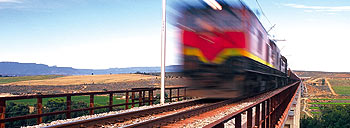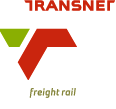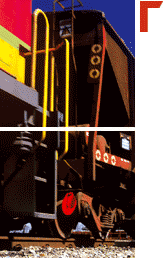
Latest 2011 Media Releases
 TRANSNET Freight Rail has begun the implementation of its scheduled railway services. The schedule specifies the path that each train takes and the arrival and departure times of each train on every node of the specified rail path.
TRANSNET Freight Rail has begun the implementation of its scheduled railway services. The schedule specifies the path that each train takes and the arrival and departure times of each train on every node of the specified rail path.
View Full Media Release as a PDF
 TRANSNET Freight Rail completely denies the allegations made by Exarro which appeared in the Business Day, 1 August 2011. TFR is of the view that Exarro’s claim in this article is an unfounded alibi which is completely misleading and mischievous. The facts of the matter are the following:
TRANSNET Freight Rail completely denies the allegations made by Exarro which appeared in the Business Day, 1 August 2011. TFR is of the view that Exarro’s claim in this article is an unfounded alibi which is completely misleading and mischievous. The facts of the matter are the following:
View Full Media Release as a PDF
 Internation Level Crossing Campaign
Internation Level Crossing Campaign
The 9th June 2011, marks the International Level Crossing Awareness Day. In an effort to celebrate and mark this day, Transnet Freight Rail, a division of Transnet Limited is embarking on a National Level Crossing and Safety Awareness Campaign with the support of some of its key stakeholders, namely the Rail Safety Regulator, PRASA, Railway Police, The SAPS, Community Forums, DOT and others.
Too many people are fatally injured in accidents at level crossings. Ignorance of both motorists and pedestrians is the main reason why statistics of human fatalities are so high. Numerous conferences have proven that the most effective way of sensitising the general public on acting safely at a level crossing is by educating communities/people about the varying risks and the consequences of not obeying the rules of rail.
View Full Media Release as a PDF
 Transnet Freight Rail Launches New Business Unit to Meet Growing Demand
Transnet Freight Rail Launches New Business Unit to Meet Growing Demand
To accommodate the increased demand for its container services and to further stimulate container and automotive growth on rail by offering a sustainable superior service, Transnet Freight Rail has created a ring-fenced business unit known as The Container and Automotive Business (CAB).
This announcement follows on the success of the turnaround of this business unit which has seen it increase its market share from 17% to 34% nationally and the ramp up from 4 trains per day to 22 per day on the Natal corridor. This unit achieved record volumes in the 2010/2011 financial year with TEU’s increasing from 525 000 in 2007/08 to 628 000 and the company expecting to handle 1.118 million TEU’s by 2016. Record volumes in the automotive sector were also recorded. Volumes increased from 102000 units 2009/10 to 131000 units 2010/11 – an impressive 29% increase.
Commenting on these achievements, TFR’s Chief Executive, Mr Siyabonga Gama, said “These impressive gains can be largely ascribed to reduction in transit times which saw the average transit time on the Natal corridor being reduced from 30 hours to 18 hours as well as the introduction of the Anaconda which created an increase in capacity from 40 - wagon to 75 - wagon train. Close collaboration with the industry has also provided customers with confidence in the unit’s capabilities and enhanced inter-modalism.”
Gama further explained that as more and more major companies put their money where their mouth is on the carbon footprint issue, TFR has strong evidence to support its competitive argument in the rail versus road debate. “Depending on volume, significant carbon footprint savings can be achieved. We estimate that a rail offering is 90% more eco-friendly than road on major routes”, said Gama.
View Full Media Release as a PDF
 TFR Increases Capacity for Railing Containers
TFR Increases Capacity for Railing Containers
Transnet Freight Rail has significantly improved its container rail service offering between the Port of Durban and Johannesburg by introducing 75 wagon container trains. The service called “the Anaconda” runs four trains a day (two to and from) three days a week moving 1800 TEU’s per week. This service is being rolled out on the Pretoria/Durban route which will move a further 2 100 TEU’s per week.
Commenting on the service, TFR CEO Mr Siyabonga Gama said the Anaconda was launched in June 2010 as a pilot. “It was fully implemented in August 2010 after exhaustive tests and training for train drivers and section managers and sign off from the Railway Safety Regulator. The service will contribute towards TFR’s efforts to maximise capacity using limited resources to meet the growing demand of containerised traffic and bridge the capacity gap. This most certainly creates a “win/ win” opportunity for both TFR and its customers and is positioned as a key enabler to accommodate future container growth”, said Gama.
“Due to the implementation of this train and it’s characteristics of mass evacuation, the TFR Container Business has managed to break its tonnage record by achieving 628 000 TEU’s against a budget of 587 347 TEU’s in 2010/2011. This record was achieved without any additional resources and relied purely on efficiency improvement initiatives. Furthermore, the Container Business budget for the 2011/2012 financial year has increased to 800 000 TEU’s. These targets will be achieved by means of additional Anaconda type of trains”.
“The Anaconda brings with it the immense evacuation capability to the terminals and harbours thereby reducing container dwell times. This has resulted in the optimal utilisation of resources by improving Wagon Turn- Around-Time and Locomotive Gross Ton Kilometres. It furthermore demonstrated faster throughput on the Durban to Johannesburg corridor and a safer option even for a longer train”, he continued.
View Full Media Release as a PDF
 Container Rail Solution for Eskom Coal Paying Dividends
Container Rail Solution for Eskom Coal Paying Dividends
Transnet Freight Rail and Eskom have introduced the innovative container solution to rail coal from various source mines to Eskom power stations. This comes not only as an effort to curb challenging deadlines, but also as an optimisation of transport solutions in delivering coal from the source to Eskom.
Transnet Freight Rail’s service to Eskom’s two power stations, Camden and Majuba, has reached the 7 million ton mark. This represents a massive 56% improvement. The demand for the current financial year (2011/2012) is 10 million tons and the intention is to move 30 million tons by rail by 2015 as more power stations units are fully commissioned.
Commenting on the initiative TFR CE Mr Siyabonga Gama said this remarkable achievement in improved performance is due to efficiency and productivity improvements. “TFR ran longer, 75 wagon trains, as opposed to the previous 60 wagon train loads at a reduced train turn around time of 54 hours compared to 63 hours in 2009/2010. The company has also increased the number of trains run per week from 29 in 2009/2010 to 36 in 2010/2011. The development of this capital efficient transport solution required close collaboration between Eskom and Transnet Freight Rail,” concluded Gama
In her remarks to the initiative, Eskom Primary Energy Divisional Executive, Kiren Maharaj said that the intervention is in line with Eskom’s medium to longer term road-to-rail migration strategy, which entails drastic reduction of heavy trucks off the road into the rail. “On the containerisation of coal, Eskom’s solution involves loading coal with front-end loaders at mines into specialised three-metre containers that are pre-placed on 50 flat-bed wagons. On arrival at Camden’s rail terminal, for example, reach stackers remove the containers and place them on road vehicles to be offloaded initially directly to stockpiles, but later to a buffer feed conveyor system operating from siding to stockpile”, explained Maharaj
View Full Media Release as a PDF
 Coal Line Derailment
Coal Line Derailment
A derailment on Transnet Freight Rail’s export coal line at 13:20 on Saturday, 22 January 2011, has resulted in the closure of the line.
40 wagons of a 200 wagon coal train derailed between Intshamanzi and Enqolothi near Ermelo. There were no injuries and the cause of the derailment is still to be determined.
Transnet Freight Rail is working around the clock to clear the site and open both lines. The first line will open at 16:00 today, Tuesday, 25 January 2011. The implications of this derailment is that 90 export coal trains have been cancelled.
Commenting on the situation, TFR Acting CEO Mr Tau Morwe said “Insofar as trying to make up for these lost tonnes, we are obviously doing our very best to make up same. However, a lost slot is exactly that, and trying to make up for lost capacity is difficult in an environment that is already under strain”.
View Full Media Release as a PDF
 Abnormally Heavy Rains and
Abnormally Heavy Rains and
Floods Disrupt Rail Traffic
Transnet Freight Rail has experienced severe disruption to its train service because of the heavy rains and floods this past month. In one incident, 5 employees who were attending to a call out were swept away at the Umfolozi River Bridge which resulted in 1 employee drowning.
The derailment of train carrying chrome at Vermont, between Belfast and Lydenburg, on the 6th of January was also as a result of heavy downpours in the area.
A wash-away at Sheepmoor, between Ermelo and Vryheid, in the early hours of the 3rd of January led to the cancellation of 18 trains of export coal. Wash-aways, causing embankment collapse and formation failure, have also led to the closure of the Harrismith/Danskraal line affecting export maize which now is diverted via Vereeniging as well as the Langlaagte/Crown line affecting fuel for Botswana. These lines remain closed.
Further aggravating the situation is that key Ports such as Richards Bay and Maputo have also been adversely affected by the inclement weather as well as the fact that many high volume customers in the coal and mining sector have been unable to load and off load rail wagons because of the heavy rains. Even the Kruger Park area has suffered the brunt of abnormally severe rain.
Commenting on the situation, TFR Acting CEO Mr Tau Morwe said that despite these temporary set-backs the Company was on track to meet customer requirements and reduce the cost of doing business in South Africa.

